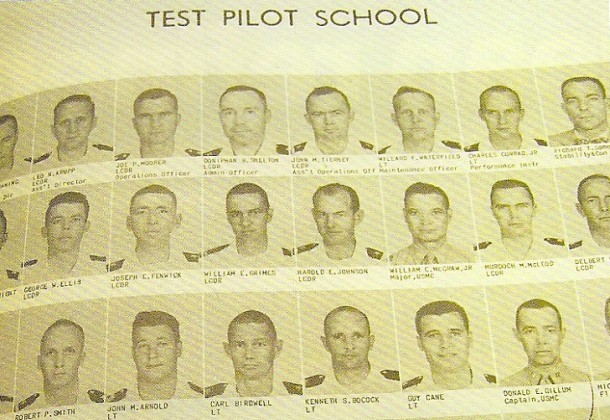Pax River Turns Its Gaze Skyward

The SlackWater Center at St. Mary’s College is a consortium of students, faculty, and community members documenting and interpreting the region’s changing landscapes. Oral histories are at the core of the center, which encourages students to explore the region through historical documents, images, literature, and scientific and environmental evidence. Some of this work is published in the print journal SlackWater, some of which is online and some published here. This article first appeared in spring 2009.
Another Step Forward: Pax River Turns Its Gaze Skyward
By Winona L. Landis
“One time … we were asked if we were natives. We told them, “No, I guess not. We came here with the Navy, but our children were born here. Does that make them natives?” And their answer took me aback. They said, “No, not unless their grandmothers were born here could they be natives.”
– John Paradis (1991)
John Paradis, a former Navy pilot and flight test engineer at the Patuxent River Naval Air Station (a.k.a. “Pax River”), always felt a bit like a foreigner in his own home. Even though he lived and worked on base for many years, he never stopped feeling like an outsider. This line of division between the locals and the base and it employees has existed since the 1940s, when the base first came to St. Mary’s. The line is never more blurred today than it has ever been. And county residents have always made one exception to the “locals only” rule. Early on, this allowance was for the Mercury Seven – the first American astronauts to go into space.
The Mercury Seven slept here. Well, four of them did. Alan Shepard, John Glenn, Wally Schirra, and Scott Carpenter had all been at Pax River. These men ate at the Roost and lived in neighborhoods like the Flat Tops, Town Creek, and Wildewood. The St. Mary’s County community took pride in the fact that three (Carpenter, Glenn, and Schirra) of the original seven astronauts were graduates of the prestigious Naval Test Pilot School at Pax River. Michael Hallett, who was a teenager during the Space Race, remembers the astronauts would laugh and drink just like any other patron, the only difference being that the walls of the Roost were adorned with pictures, squadron patches, and various other paraphernalia that marked their achievements. These men had become symbols of local pride. Hallett recalls, “Everyone was excited when another step [in the race to space] was taken.”
“[W]hen the Russians put up [the Sputnick satellite], everybody went crazy, saying, “What are we going to do?” remembers John “Al” Barolet, an engineer in the Electronics Test division at the dawn of the race to space.
“The Navy gave a contract to a firm up in Washington … They came down here and utilized our help in the antenna branch, and why they were here was to observe missile launches in Cape Canaveral in Florida, and this is what they call over-the-horizon radar. So, we put up antennas and we watched them shoot missiles from the ground up in Florida and they wouldn’t tell us when they were going to do it. We had to monitor those screens and watch for a big spike and that big spike was a missile launch in Florida. And the basis of the whole thing is we proved that you can watch for a missile launch at a distance, depending on how good an antenna you put up. So you know, we were really looking for missile launches in Russia and that was the set up.”
Native countian James “Jim” Raley, who worked at the Naval Air Test Center during the astronauts’ tenure there, remembered them fondly, Alan Shepard in particular.
“Alan Shepard was just one of the most impressive men I’ve ever met in my life … When they selected him to be a member of the original astronauts, I said, ‘He’ll be the first man in space.’ I didn’t know anymore what they were going to do, but I said, ‘He’ll be fine.’ Now, he didn’t go around the globe like John Glenn, but Alan Shepard was first because he was so competitive that he had to be first or he couldn’t have lived with himself. He was a leader and everyone wanted to follow him.”
As important as the space program was, it was just a small part of the total operation at Pax River. Bob Russell, who worked on base for over 40 years and was director of the U.S. Naval Test Pilot School from 1994 to 1999, recalls, “It was a really big deal for the Navy that the astronauts came out of Pax River, but there were other important things going on at the base during that time. A lot of really important innovations were being made in fields like aviation.”
John Cook, a local who maintains close relationships with base employees past and present, shares the same sentiments as Russell.
“In the beginning, NASA wanted the astronauts to come through the Test Pilot School, but after the moon landing they started wanting their astronauts to be more like scientists. Overall, Pax River was really not all that dedicated to the Space Race. I’d say Vietnam was really more important in the ’60s, what with weapons transport and all.”
After the Mercury Project ended in 1963, Pax River continued to provide training and other support for those who would eventually venture into space, as part of the Gemini and Apollo programs and the current space shuttle program. Since them, the line between native county and Navy county, while not entirely gone, is now more one of collaboration rather than distance. Not only does no one think that the Navy is leaving anytime soon, elected officials with old county names like Dement, Jarboe, Mattingly, McKay, Raley, and Russell work hard to protect the base from anything that would endanger its survival.
SPONSORED BY
























